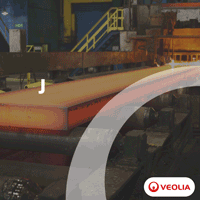ThyssenKrupp Steel Makes Additional Investment in Particulates Reduction
09/26/2008 - ThyssenKrupp Steel invests an additional 30 million euros to equip its sinter plant in Duisburg-Schwelgern with additional filters to capture particulates and dust-containing off-gases.
ThyssenKrupp Steel is investing an additional 30 million euros to equip its sinter plant in Duisburg-Schwelgern with additional filters to capture particulates and dust-containing off-gases. The investment will help the company reduce particulate pollution in the north of Duisburg, ensuring that the European Union emissions standards are met in the region.
ThyssenKrupp has made a total of 41 measures in the past toward the improvement of air quality. As confirmation of the success of these measures, the state environmental authority has stated that particulate pollution in the north of Duisburg has decreased by more than 20% since 2002, vs. measurements in heavy traffic areas, e.g., where particulate levels have remained virtually constant.
ThyssenKrupp Steel accounts for around 20% of the particulate pollution in the north of Duisburg. This was shown by an investigation program carried out jointly with the Ministry for Environment and Nature Conservation, Agriculture and Consumer Protection of the state of North Rhine-Westphalia. The two-year investigation also showed that 60% of the particulate matter recorded at the measuring points in Duisburg-Marxloh and Duisburg-Bruckhausen is carried in by the wind from surrounding and more distant areas. The study showed that another 20% of the particulates comes from traffic and domestic fuel combustion. Domestic fuel burning includes the coal stoves still used to heat an above-average number of homes in the north of Duisburg.
ThyssenKrupp Steel’s 30-million-euro investment in the sinter plant will further reduce the company's share of local particulate emissions. ThyssenKrupp Steel’s sinter plant, which it uses to convert fine ore into a coarse-grained material that is later charged in the blast furnace, produces around twelve million tonnes of sinter per year. The sinter plant is already equipped with filters having a total surface area of 150,000 square meters; these filters clean approximately a hundred billion cubic meters of gas per year, with the captured iron-bearing dusts being cycled back to the sinter plant.
To improve control of particulate emissions still further, among other things ThyssenKrupp Steel will be installing an additional fabric filter downstream of the existing electrostatic gas cleaners. In addition, new high-voltage electrostatic precipitators will be used to separate particulates inside the sinter belt areas. Further particulate sources will be connected to the improved dust collection systems.
This action by ThyssenKrupp Steel goes beyond the measures recommended by the recently published Clean Air Plan for the western Ruhr. The company estimates the filter concept for the sinter plant will reduce particulate pollution in the north of Duisburg by up to 3 micrograms per cubic meter.
"The aim behind this voluntary measure is to help achieve a sustainable improvement in the particulate situation in the north of Duisburg," says Dr. Gunnar Still, head of Environmental Affairs at ThyssenKrupp Steel. "However our company cannot bring about lasting compliance with the standards on its own. The background pollution from other sources is too great. Further efforts at federal and state level and an intensive dialogue among all parties are needed."
Reducing dust emissions has always been an important issue for ThyssenKrupp Steel. In recent years, the company has launched wide-ranging programs that have led to a significant reduction in dust pollution. The most recent example is Blast Furnace No. 8, commissioned in December 2007, with its unique 20-million-euro dust-collection system for capturing emissions during rail-car unloading. Altogether, a quarter of the company’s 250-million-euro investment in the new blast furnace was spent on pollution control. Together with the North Rhine-Westphalia environmental agency, it has been proven that the new blast furnace produces virtually no uncontrolled diffuse dust emissions.
In October 2004, ThyssenKrupp Steel began operation of a system to collect dust emissions from the casthouse and stockhouse of Blast Furnace No. 1. The 16.5-million-euro unit cleans 1.8 million cubic meters of air per hour via 18 different extraction points. The investment was part of a 62-million-euro program to reduce dust emissions from the Schwelgern plant unit, in the course of which the rotary coolers in the sinter plant were also enclosed at a cost of 33 million euros.
"The aim behind this voluntary measure is to help achieve a sustainable improvement in the particulate situation in the north of Duisburg," says Dr. Gunnar Still, head of Environmental Affairs at ThyssenKrupp Steel. "However our company cannot bring about lasting compliance with the standards on its own. The background pollution from other sources is too great. Further efforts at federal and state level and an intensive dialogue among all parties are needed."
Reducing dust emissions has always been an important issue for ThyssenKrupp Steel. In recent years, the company has launched wide-ranging programs that have led to a significant reduction in dust pollution. The most recent example is Blast Furnace No. 8, commissioned in December 2007, with its unique 20-million-euro dust-collection system for capturing emissions during rail-car unloading. Altogether, a quarter of the company’s 250-million-euro investment in the new blast furnace was spent on pollution control. Together with the North Rhine-Westphalia environmental agency, it has been proven that the new blast furnace produces virtually no uncontrolled diffuse dust emissions.
In October 2004, ThyssenKrupp Steel began operation of a system to collect dust emissions from the casthouse and stockhouse of Blast Furnace No. 1. The 16.5-million-euro unit cleans 1.8 million cubic meters of air per hour via 18 different extraction points. The investment was part of a 62-million-euro program to reduce dust emissions from the Schwelgern plant unit, in the course of which the rotary coolers in the sinter plant were also enclosed at a cost of 33 million euros.



-(220-x-200-px)-(130-x-130-px)-(220-x-200-px).jpg?lang=en-US&ext=.jpg)
.gif?width=200&height=200&mediaprotectionhash=ddb07947ad3b4ab959a83714461eccd5c6895f370695eb035a9ff7aa736f8ad9&ext=.gif)





